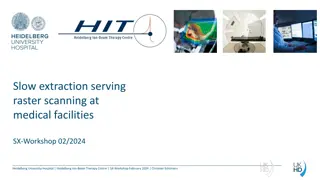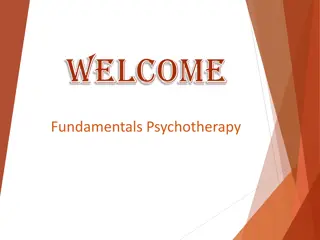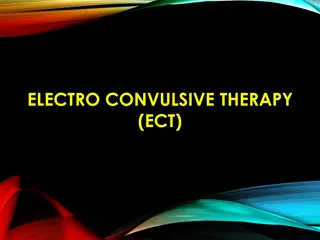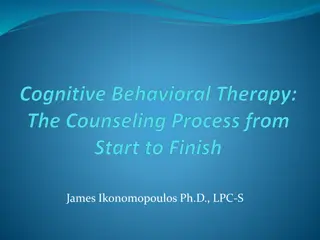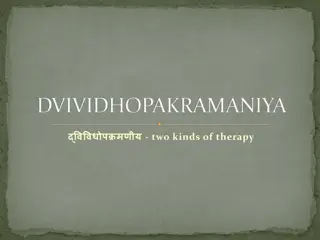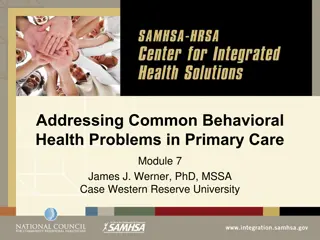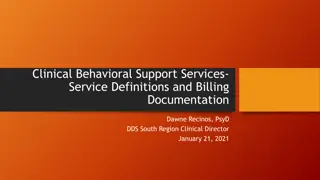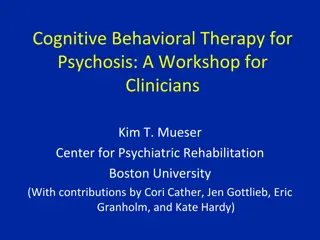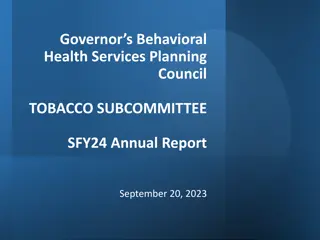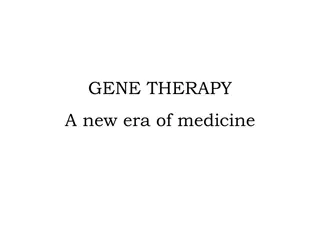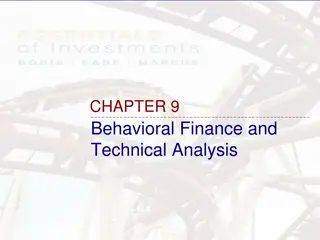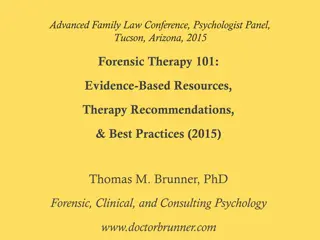Understanding Behavioral Therapy in Psychotherapeutics
Behavioral therapy focuses on observable behavior and learning experiences to bring about change and enhance skills. It is used to treat a wide range of psychological disorders and is applicable in various fields such as developmental disabilities, education, clinical psychology, and rehabilitation. Key areas of development include classical conditioning, operant conditioning, social cognitive theory, and cognitive-behavioral therapy. The therapeutic process involves setting clear goals, continual assessment, and utilizing the ABC model to address problem behaviors. Therapists play an active and directive role in helping clients achieve desired outcomes.
- Behavioral Therapy
- Psychotherapeutics
- Psychological Disorders
- Therapeutic Process
- Cognitive-Behavioral Therapy
Download Presentation

Please find below an Image/Link to download the presentation.
The content on the website is provided AS IS for your information and personal use only. It may not be sold, licensed, or shared on other websites without obtaining consent from the author. Download presentation by click this link. If you encounter any issues during the download, it is possible that the publisher has removed the file from their server.
E N D
Presentation Transcript
BEHAVIOURAL THERAPY
CONTENTS Introduction Four areas of development Key Concepts Therapeutic Process Therapeutic Techniques and Procedure Conclusion References
INTRODUCTION Behavioural therapy focus on directly observable behavior ,current determinants ,learning experience that promote change and rigorous assessment and evaluation. Treat wide range of Psychological disorder. Anxiety disorder, depression, posttraumatic stress disorder, sexual disorder etc Used in the field of developmental disabilities, education and special education, clincal Psychology, Rehabilitation etc
FOURAREASOFDEVELOPMENT Classical Conditioning Operant Conditioning Social Cognitive Theory Cognitive Behavioral Therapy
KEYCONCEPTS 1) View of Human Nature Systematic and structured approach to Counselling. Give control and freedom to the client. Aims to increase people skill Help to attain humanistic ends
2)Basic Characteristic and Assumptions Principle of learning help to change maladaptive behaviour. Behaviour also include internal process. Deals with client s current problem and factors influencing them to modify performance. Operate to change the behaviour by understanding. Assessment is an ongoing process of observation and self monitoring. Behavioural treatment interventions are to solve specific problem experienced by client.
THERAPEUTICPROCESS 1)Therapeutic Goals Goals play a central importance in behavioural therapy. Specific treatment goals at the outset of therapeutic process. Continual assessment add treatment occur to determine the behaviour to change. Goals must be clear, understood and agreed on by client and counselor.
2)Therapist Function and Role o ABC model o A-Situational Antecedent,B-Behaviour, C-Consequence of problem. o Practioner tend to be active and directive function as consultant and problem solvers. o Clinician uses strategies that have research support for problem.
3)Client Experience in Therapy Therapist provide a well defined system of procedure to employ. Therapy based on the active role of both client and therapist. Co. Operate with therapeutic activities during therapy and daily life. Client should be encouraged repeat the adaptive behaviour.
4)Relationship between Therapist and client o Establish the relationship between client and therapist. o Flexible relationship styles+ wide range of techniques=treatment outcome. o Help to change.
THERAPEUTICTECHNIQUES ANDPROCEDURE The strength of behavioral approach is the development of therapeutic procedure. Empirically supported In cooperate different techniques that effectively change behavior. Various techniques are available to the Practioner,
1)Operant Conditioning Techniques a)Positive Reinforcement b)Negative Reinforcement c)ExtinSion d)Positive and Negative Punishment
2)Progressive Muscle Relaxation A method of teaching people to cope with stresses produced by daily livings. Achieve muscle relaxation and is easily learned. Jacobson initially developed this procedure. It is frequently used in combination with other behavioural techniques.
3)Systematic Desensitization This procedure which is based on the principle of Classical Conditioning is a behavioural procedure developed by Joseph Wolpe. Empirically researched behavioural therapy. The step process a)Relaxation training b)Development of anxiety hierarchy c)Systematic Desensitization
4)Eye movement desensitization and Reprocessing(EMDR) EMDR is a form of Exposure Therapy which entails assessment and preparation, Imaginal flooding and cognitive restructuring with traumatic events. Treatment consist of 3 phases a)Assesment and Preparation b)Imaginal Flooding c)Cognitive Restructuring
5)Social Skill Training It is a broad category deals with the individuals ability to interact effectively in various social situation. Develop and achieve skills in interpersonal competence. Effective Communications. It is helpful in ADHD, behavioural problem, anger management training. Assertion training
CONCLUSION Four Areas of Development Key Concepts Basic Characteristics and Assumption Therapeutic Process Therapeutic Techniques and Procedures
REFERENCES Corey.G.(2001):Theory and Practice of Counseling and Psychotherapy.New Delhi,Brooks/cole. https://www.psychotherapeutics www.psychotherapeuticsimages.com https://www.behaviouraltherapies


